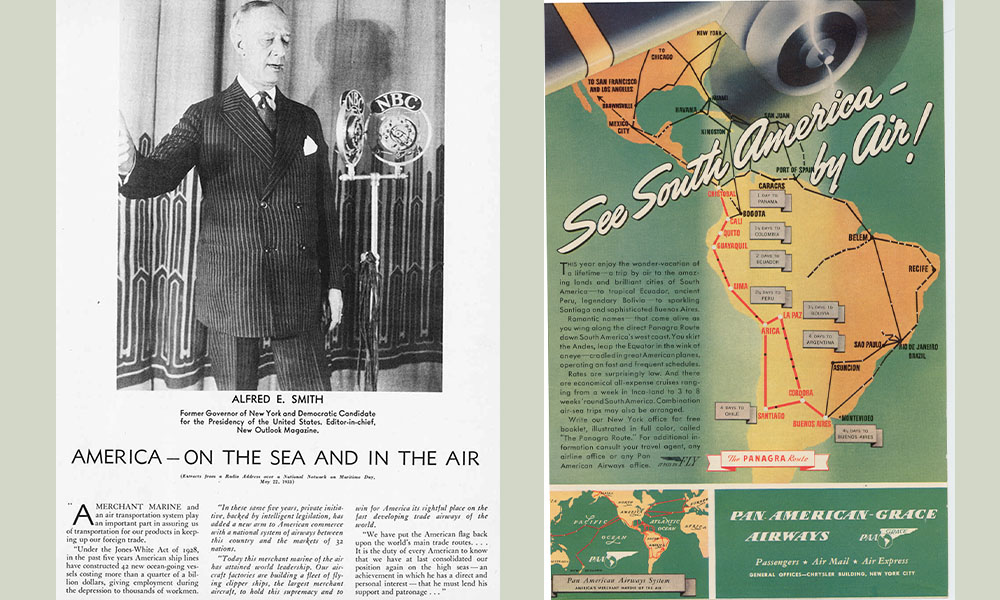Pan Am: May1933
MAY
Scroll down to read
Five May 1933 posts
MAY 04, 1933
"It’s Impossible: Standardizing Paperwork
Across Two Continents"
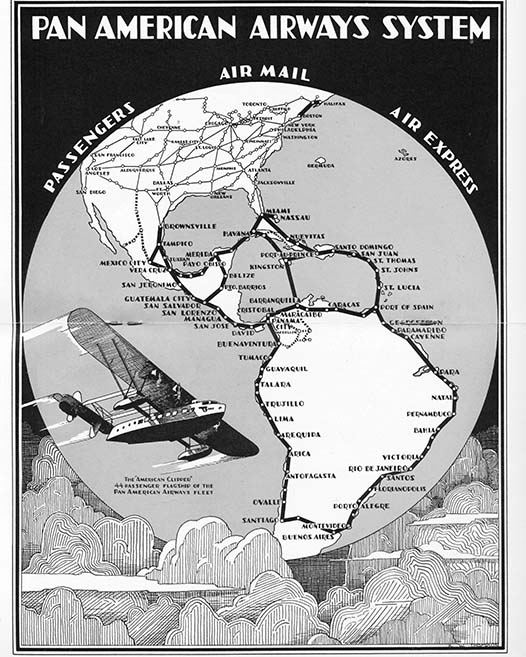 Pan American Airways System Map, 1932 Annual Report, p. 12
Pan American Airways System Map, 1932 Annual Report, p. 12
The paperwork needed to move passengers, mail, and freight in and out of thirty-two countries swamped Pan American Airways because each employed idiosyncratic, multi-step, often-inscrutable processes.
The paper problem was multi-variable. Form completion ate time and often delayed departures along the company’s multi-stop routes. Larger capacity aircraft – passenger and freight load -- exacerbated the problem. By 1931 the forms for the eight-thousand-mile, eleven-country Miami-to-Buenos Aires route were loaded as a bale on southbound Consolidated Commodores with each pound displacing high-yield express freight.
In 1933, Pan Am Foreign Department’s process-standardization efforts paid off when the “Pan American Airway Bill” (a uniform air-express document) and the “Documento Unico” (a uniform airplane-clearance form) and an expedited customs process for passengers were ratified by countries throughout the Caribbean, Central and South America. Uruguay’s government approved the Airway Bill on May 6, 1934 as the thirty-first country in a one-form-fits-all consortium: one form now replaced “commercial invoices, consular invoices, customs declarations and other forms required for international shipments by other forms of transportation.” (“Pan American Air Ways,” Vol 4, No. 1, March 1933, p.9)
Sources:
Banning, Eugene. “Airlines of Pan American Airways since 1927,” Paladwr Press, 2001.
“Pan American Air Ways,” Vol. 3, No. 4, October 1932 /
Vol 4, No. 1, March 1933/ & Vol. 4, No. 3, June, 1933. (University of Miami, Special Collections & PAHF Collection)
Photo: Pan Am 1932 Annual Report.

MAY 10, 1933
“PAA Carries Tons of Tunes”
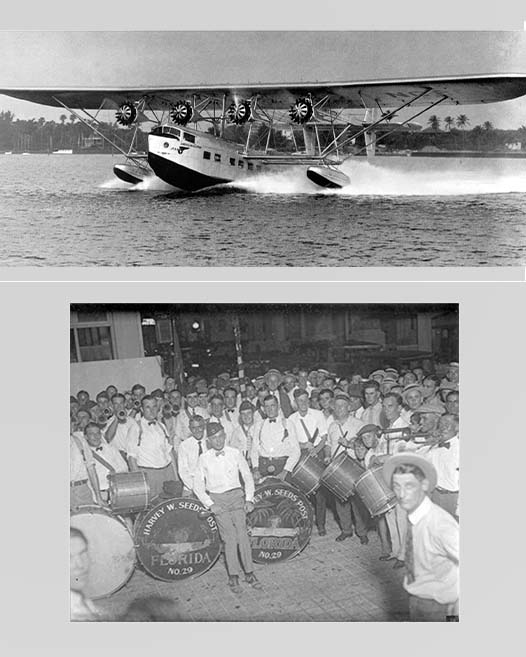
• Sikorsky S-40, American Clipper (Pan Am Historical Foundation Collection).
• Harvey Seeds post of the American Legion Drum Corps in front of the post office, Miami, 1926. Photographer: Gleason Romer, Miami-Dade Public Library System collection. https://digitalcollections.mdpls.org/digital/collection/p17273coll3/id/13279/rec/2
After shooing Wednesday, May 10, 1933, scheduled flights east to Nassau, Bahamas, and south to Havana or Nuevitas, Cuba, and points beyond, Pan American Air Ways’ Dinner Key personnel pivoted to the day’s big charter.
Pan Am was flying an eight-four-member Miami American Legion delegation to Havana, Cuba for the 1933 Florida State convention (during Prohibition the Florida Legionnaires wanted a “wet” gathering). The contract stipulated that the fifty-one member Harvey Seeds Post Drum and Bugle Corps get to Havana in time to assemble at the Havana docks to greet steamships carrying hundreds of Florida Legionnaires. The band was the Florida Legion’s pride, acknowledged as the United States’ premier Legion band and it wanted to travel in style on Pan American Airways’ newest and largest aircraft, the forty-seat, state-of-the-art, attention-getting Sikorsky S-40 “Clipper.”
This “lift puzzle” was three-dimensional: S x B x W = Load.
(S: seats required, B: baggage volume, and W: combined weight, although lightweight, drums, occupy more cubic space than bugles and mailbags and suitcases.)
Regardless of the load challenge, Pan Am accepted the job because charters provided above-budget revenue, and the S-40’s baggage/freight holds were larger than other aircraft used on the Miami-Havana run, the Sikorsky S-38 and the Consolidated Commodore.
Still, fourteen Harvey Seeds Post drummers/buglers drew short straws and watched the American Clipper (NC80V) head south without them that morning. These musicians boarded a Consolidated Commodore minutes later, however and the remaining dozen Miami legionnaires and the group’s luggage made the southbound trip soon after in a second Commodore. Pan Am’s Public Relations team heralded the charter as an aviation first, crowing that “Probably for the first time in history an entire Drum Corps of fifty men traveled by plane to a convention.” (Pan American Air Ways," Vol. 4., No. 4, July- August, 1933, p.3 )
Source:
"Pan American Air Ways," Vol. 4., No. 4, July-August 1933.
"Notes
Harvey Seeds members were part of the recovery efforts after the Great Miami Hurricane of 1926. They sent rescuers and supplies to Okeechobee after the 1928 hurricane. They helped their brother veterans after the 1935 hurricane and raised money for their burials as well as a memorial." (MDPLS)

MAY 17, 1933
“The Key to Catching a Cat”
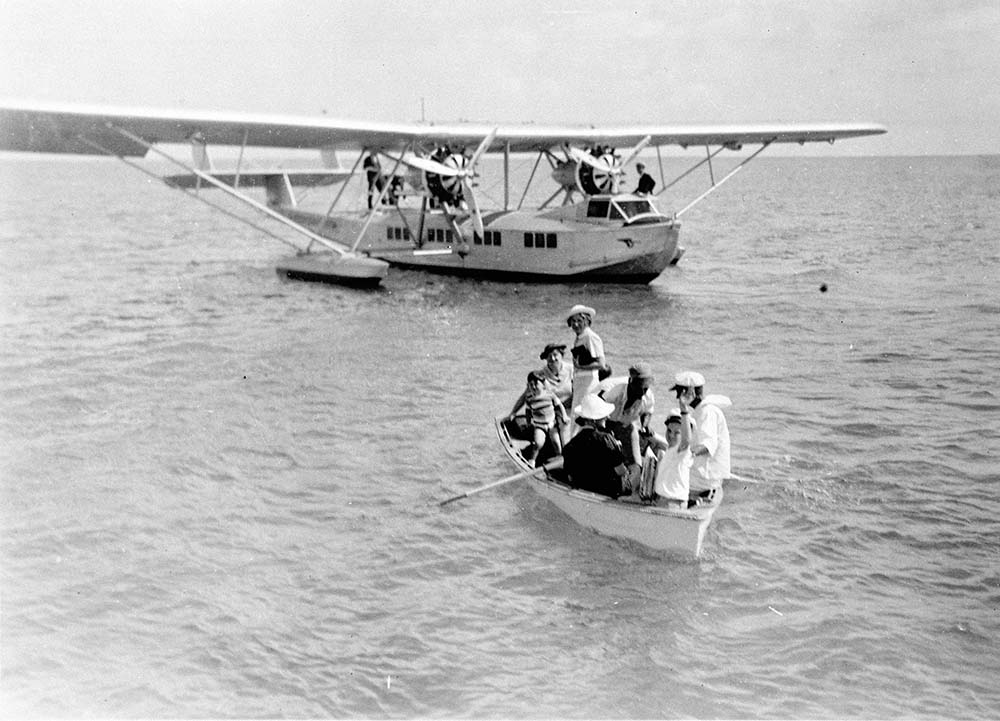
Photo: Author Ernest Hemingway spent a lot of time on Cat Cay with his family around that time. This photo from the PAHF/Hemingway Collection shows a Pan American Airways Commodore with passengers (possibly Hemingway's sons), coming ashore in a row boat at Cat Cay, Bahamas in the late 1930s (PAHF/Ernest Hemingway Collection, JFK Library).
Pan American Airways had flown from Miami, Florida to Nassau, Bahamas since 1929, elbowing out scheduled-service competition, leaving the small-load charter market to the Glenn Curtiss flight service with antiquated flying boats such as the Curtiss MF Seagull and Ireland N-E Neptune.
Still, Pan Am didn’t ignore wealthy sportsmen asking for drop-off/pick-up requests at fishing outposts along the company’s standard Miami-Nassau flight path, especially after twenty-two-seat Consolidated Commodores began to ply the route in mid-1931. These aircraft tripled seating capacity, reduced flight time, and provided greater comfort than the route’s long-serving Sikorsky S-38As, especially unit NC-8000, Pan Am’s first S-38 purchase, that had flown for more than five year, primarily on this milk-run.
Demand for Miami-Nassau en route stops increased, particularly for drop-off/pick-up at Cat Cay, a celebrity sportsman’s getaway. One-hundred-and-four passengers bought a one-way ticket to Cat Cay in the first quarter of 1933 and did so in greater numbers and at a higher per-mile rate than a standard Miami-Nassau ticket rate.
Capitalizing on customer willingness to pay fare premiums, Pan Am initiated a Miami-Cat Cay, Bahama route. The sixty-mile route (each way) offered benefits beyond cash flow: its aging, eight-seat Sikorsky S-38s fit the route perfectly; minimal navigation challenges (point the nose due east outbound, and due west inbound) helped less-experienced pilots hone their skills and built flight hours (albeit slowly) required to advance to longer routes aboard more-complex, less-forgiving airplanes.
Source:
“Pan American Air Ways,” Vol. 4.No. 3, June 1933, p. 24. https://digitalcollections.library.miami.edu/digital/collection/asm0341/id/41048/rec/3

MAY 24, 1933
“New Slogan Gifted to PAA”
• (Left) Al Smith, New York Governor, "America - On the Sea and in the Air,” Merchant Marine of the Air speech May 22, 1933. "Pan American Air Ways," Vol. 4, No. 3, June 1933, p.20. https://digitalcollections.library.miami.edu/digital/collection/asm0341/id/41044/rec/3
• (Right) 1940's Pan Am Ad "See South America" promoting the slogan "Merchant Marine of the Air" (PAHF Collection).
While Juan Trippe and Pan American Airways used the tagline “the Merchant Marine of the Air” for decades, the iconic phrase didn’t come from his lips. Rather, New York political stalwart, Al Smith (former New York State Governor and a one-time United States Presidential candidate) laid the moniker on Pan American Airways during a nation-wide radio address, May 22, 1933, in honor of National Maritime Day.
Starting with American shipping growth, Smith stated, “in the past five years American ship lines have constructed 42 new ocean-going vessels costing more than a quarter of a billion dollars, giving employment during the depression to thousands of workmen.”
“In these same five years,” he continued, “private initiative, backed by intelligent legislation has added a new arm to American commerce with a national system of airways between this country and the markets of 32 nations” (Pan Am, not named directly, was America’s only airline serving more than two countries).
“Today this merchant marine of the air has attained world leadership. Our aircraft factories are building a fleet of flying clipper ships, the largest merchant aircraft, to hold this supremacy and to win for America its rightful place on the fast developing trade airways of the world.” “We have,” Smith concluded, “put the American flag back upon the world’s main trade routes.” (p.20)
Pan Am’s marketing team seized on the concept and the phrase, “merchant marine of the air,” was a mainstay of Pan Am materials for the next two decades.
Sources:
• Banning, Eugene. "Airlines of Pan American Airways since 1927," Paladwr Press, 2001.
• "Pan American Air Ways," Vol. 4, No. 3, June 1933.
Photo montage:
• Al Smith, New York Governor, "America - On the Sea and in the Air,” Merchant Marine of the Air speech May 22, 1933. "Pan American Air Ways," Vol. 4, No. 3, June 1933, p.20. https://digitalcollections.library.miami.edu/digital/collection/asm0341/id/41044/rec/3
• 1940's Pan Am Ad "See South America" promoting the slogan "Merchant Marine of the Air" (PAHF Collection).

MAY 31, 1933
“Growing in Mexico”
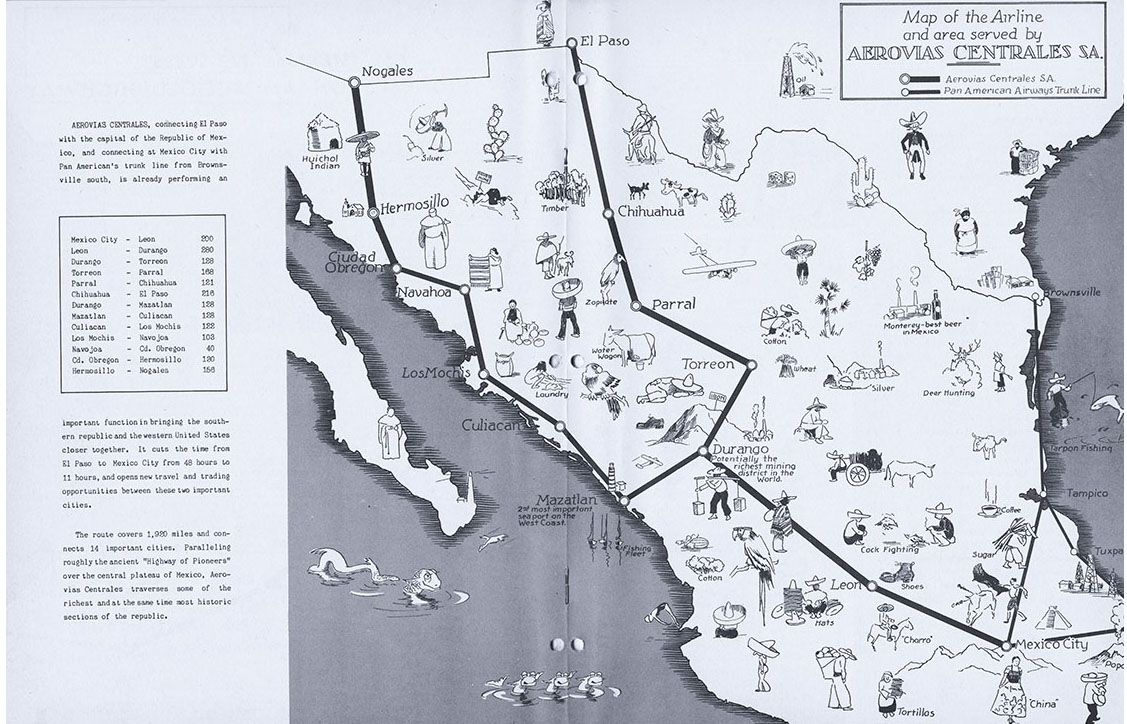
Map: Aerovias Centrales, S.A. & Pan American Airways Trunk Line. (“Pan American Air Ways,” Vol. 4, No. 5, October 1933, p. 14) https://digitalcollections.library.miami.edu/digital/collection/asm0341/id/41155/rec/
Pan American Air Ways announced in mid-May 1933 that Aerovías Centrales S.A., an affiliate created fifteen-months earlier to fill the Mexico domestic-service hole created by Corporatión de Aeronáutica de Transportes’ failure, now linked the cross-border city Nogales (Mexico/Arizona) to Mexico City on a 1,300-mile, nine-stop route.
The new Aerovías Centrales S.A. branch line opened western United States customers to air commerce throughout Central and western South America, even business opportunities throughout the Caribbean and South America’s eastern shore. The “west-coast” route intersected Aerovías Centrales S.A.’s existing 1,200-mile, six-stop Mexico City to El Paso line at Durango, 480 miles north of Mexico City. Pan Am’s other Mexican domestic airline, Compañía Mexicana de Aviación, S.A., shared its Mexico City operations base with Aerovías Centrales S.A. making Mexico City Pan Am’s western operational center for its growing air network.
Aerovías Centrales S.A.’s moment in aviation history was short-lived. Aviation historian, R.E.G. Davies, writes that “On 18 December, 1935, Aerovías Centrales itself was dissolved, mainly because Pan American refused to comply with the new Mexican law directing that all flying crew must be Mexican nationals.” (14) Still, corporate assets shifting allowed Pan Am to maintain its trans-Mexico operations via Mexico’s east and west coasts to Mexico City which was essential to maintaining and growing it North to South America airways business monopoly.
Sources and Photo:
• Davies, R.E.G. “Airlines of Latin America since 1919.” Smithsonian, 1984.
• “Pan American Air Ways,” Vol. 4, No. 5, October 1933, pp. 13-14. https://digitalcollections.library.miami.edu/digital/collection/asm0341/id/41155/rec/5

Go back to "90 Years Ago" main page

